Wild Rift Tournament Scene 2025: Formats, Events, and Regionals
Updated On: November 29, 2025 by Aaron Connolly
Wild Rift Esports Overview 2025
Wild Rift esports is shaking things up in 2025. Riot Games is rolling out new tournament formats and building stronger connections to League of Legends pro play.
They’re focusing more on community-driven competitions and celebrating esports history with special in-game content. It’s a fresh direction, honestly.
Key Updates for 2025
This year, Wild Rounds and Organised Play take center stage for Wild Rift esports. Riot Games ditched the old-school tournament formats in favor of something more fun and community-based.
Now, pro players and influencers play together in the same system. Fans at the grassroots level get closer to the action than ever before.
It’s a big switch from the usual esports setups in other games.
Regional tournaments still play a huge role in the scene. The Rift Legends circuit features both Open and Showdown events, running from February to June for the Spring Split.
Tournament organizers now put more energy into engaging content around each match. There’s a bigger focus on entertainment and personality, not just winning or losing.
That’s making the events way more approachable for casual viewers.
Ecosystem Structure
The Wild Rift competitive scene splits into several tournament levels:
| Tournament Type | Duration | Focus |
|---|---|---|
| Rift Legends Open | Feb-June | Regional competition |
| Rift Legends Showdown | 2 days | Best EMEA teams |
| From Ashes to Glory | 2 days | Specific regional events |
| Wild Rounds | Ongoing | Community-driven |
The Wild Circuit acts as the main competitive path. Teams move through multiple regional tournaments across the year.
Community tournaments matter even more in 2025. They bridge pro play and amateur competition, letting local organizers run their own events inside the official structure.
The spring season usually lasts the longest. Summer and autumn bring shorter, high-intensity tournaments.
Connection to League of Legends
Wild Rift is leaning into its League of Legends esports roots with special Worlds 2025 content. Players can earn exclusive rewards that honor legends like Faker, Showmaker, and Uzi.
This crossover content helps bring PC and mobile fans together. Wild Rift players get a taste of classic LoL esports history.
It’s also a way to introduce mobile-only players to the bigger competitive scene.
Worlds 2025 integration marks a real shift in how Riot links its games. Wild Rift now feels like it’s part of the broader League of Legends esports celebration.
That opens up more chances for cross-promotion.
By spotlighting esports heritage, Riot is giving Wild Rift more credibility as a competitive title. Honoring LoL legends helps the mobile game earn respect from traditional esports fans.
Riot Games’ Role and Organised Play

Riot Games is stepping up in Wild Rift esports by hosting more tournaments directly and building community partnerships.
They plan to jump from 11 tournaments in 2024 to 18 Regional Wild Rounds events in 2025. Riot’s also looking to work with third-party groups to boost grassroots competition.
Riot Games Partnerships
For now, Riot Games runs most Wild Rounds tournaments themselves. Still, they’re reaching out to experienced tournament organizers to help expand.
They know local tournament organisers are key for regional communities. These partnerships are supposed to make Wild Rounds tournaments even better, while keeping Riot’s community-first vibe.
Some benefits of these partnerships:
- Better local expertise and cultural understanding
- More tournament coverage in different regions
- Stronger community engagement through existing networks
- Shared resources for higher production value
Riot says they’ll share more about these partnerships later in 2025. This way, they keep control over quality but still get help from outside pros.
Third-Party Organisers
Groups like The Purge Tournament already help run Wild Rift esports. The Rift Legends Showdown happened from 31 May to 1 June 2025, with top EMEA teams and Riot’s support.
These partnerships show Riot is open to working with outside organizers. The Wild Circuit 2025 events, including the Rift Legends Spring Split, highlight how well third-party groups can handle things.
Why bring in third parties?
- They know their regions and have strong connections
- Riot doesn’t have to do all the heavy lifting
- You get different tournament formats and ideas
- Local communities feel more involved
The Purge Tournament’s €2,000 prize pool shows smaller organizers can still deliver great competitions. This setup helps Riot grow the esports scene without stretching themselves too thin.
Grassroots Development
Riot Games is putting grassroots development front and center with expanded organised play. The Wild Rounds Pilipinas Open 2025 is a standout example of their approach in key regions.
Soon, community organizers, creators, and even friend groups will get tools to run their own tournaments. Riot wants everyone to have a shot at competitive Wild Rift.
Grassroots expansion covers:
- Quarterly tournaments in Brazil, Korea, Philippines, Turkey, and Vietnam
- Community-hosted tournament options
- Support for influencer and creator events
- Tools for friends to set up their own competitions
Each region gets its own tournament formats and prize pools that fit local tastes. This focus on local flavor means tournaments actually serve their communities.
Everything builds up to Wild Rounds: SMASH, where influencers, community players, and pro teams from different regions all compete together.
Wild Rounds Expansion
Riot Games has gone big with Wild Rounds in 2025. They’ve grown from 11 tournaments to 18 regional events across five main regions.
Now, each region gets quarterly tournaments, unique prize setups, and more community partnerships.
Regional Wild Rounds Events
The 2025 rollout brings Wild Rounds to Brazil, Korea, Turkey, Vietnam, and the Philippines. Every region runs three tournaments a year—May/June, August/September, and November/December.
This schedule gives local communities more regular chances to compete. The Philippines leads the way with a 1.5 million PHP prize pool for their Pilipinas Open 2025.
Every region’s tournament comes with its own format and rewards. Riot Games tweaks each event to fit what local players want.
Brazil’s CarnaWild just wrapped up as the first regional event of 2025. That tournament’s success really shows how regional customization can pay off.
| Region | Prize Pool | Tournament Name | Quarter Schedule |
|---|---|---|---|
| Philippines | 1.5M PHP | Pilipinas Open | Q2, Q3, Q4 |
| Brazil | TBC | CarnaWild Series | Q2, Q3, Q4 |
| Korea | TBC | Wild Rounds KR | Q2, Q3, Q4 |
Community and Influencer Involvement
Wild Rounds keeps building on the 2024 SMASH event’s success, blending pro players with influencers and regular community members.
Last year, the event split into pro and influencer tracks, plus mixed relay competitions.
JT won the Pro track in 2024, and SNG from the Philippines took the Influencer track. Those mixed events made for some seriously fun viewing.
Riot Games is now looking to partner with local organizers instead of running everything themselves. They see how important community groups are for growing regional scenes.
Pretty soon, community organizers and creators will be able to host their own affiliated tournaments outside the main Wild Rounds. Riot says they’ll announce these new partnerships later in 2025.
Event Format Innovations
Wild Rounds isn’t afraid to try new things. Instead of sticking to standard 5v5 matches, events now feature 1v1 showcases, 2v2 team relays, and mixed pro-influencer competitions.
This year’s regional tournaments all lead up to the big Wild Rounds: SMASH event. That championship brings in players from all six regions, including China, and mixes pros with community reps.
Each region tweaks its format for local tastes. The Philippines leans heavily into grassroots engagement, while other regions highlight different competitive angles.
Quick tip: If you want the latest on your region’s tournaments, follow the Wild Rounds regional accounts on social media.
The experimental formats from 2024 worked out well, so Riot is spreading those ideas across all regional events this year.
Wild Rounds: SMASH Grand Finals
Wild Rounds: SMASH is Wild Rift’s top cross-regional tournament. It brings together pro teams and influencers, mixing up traditional 5v5 matches with new relay formats.
Qualifying paths vary, with some teams earning spots through regionals and others getting direct invites.
Tournament Structure
SMASH splits into three main tracks. The Pro Track 5v5 puts the best pro teams from each region head-to-head.
The Influencer Track 5v5 lets streamers and content creators compete just like the pros. This track’s actually become a fan favorite—SNG from the Philippines won it last year.
Then there’s the Team Relay, which is kind of wild. It mixes 1v1 and 2v2 matches, with pros and influencers teaming up.
| Track Type | Format | Participants |
|---|---|---|
| Pro Track | 5v5 | Professional teams |
| Influencer Track | 5v5 | Content creators |
| Team Relay | 1v1 + 2v2 | Mixed pro/influencer |
Participating Teams and Influencers
SMASH features players from six regions: Brazil, China, Korea, the Philippines, Turkey, and Vietnam.
Most pro teams come from China, where Wild Rift is still incredibly popular competitively.
Influencers join from every region, bringing in their own fans and play styles. Brazil’s WCP and Korea’s TS have had strong showings in the past.
Mixing pros with influencers creates storylines you just don’t get in regular tournaments. Fans can watch their favorite streamers play alongside top-tier pros.
Regional diversity means global viewership and a bunch of different playstyles. Every region brings something new to the table.
Paths to Qualification
Regional Wild Rounds tournaments act as the main qualifier for SMASH. These 18 tournaments happen in five regions, running three times a year—usually in May/June, August/September, and November/December.
Direct invitations fill out the rest of the roster, especially for big-name pros and influencers. Riot Games picks these based on skill and community impact.
Teams get several shots at qualifying thanks to the quarterly schedule. One bad run doesn’t end your SMASH dreams.
Some spots go to participants who contribute through content creation or community engagement, not just pure gameplay. That helps SMASH keep its focus on the whole Wild Rift community, not just the elite.
Regional Tournament Circuit
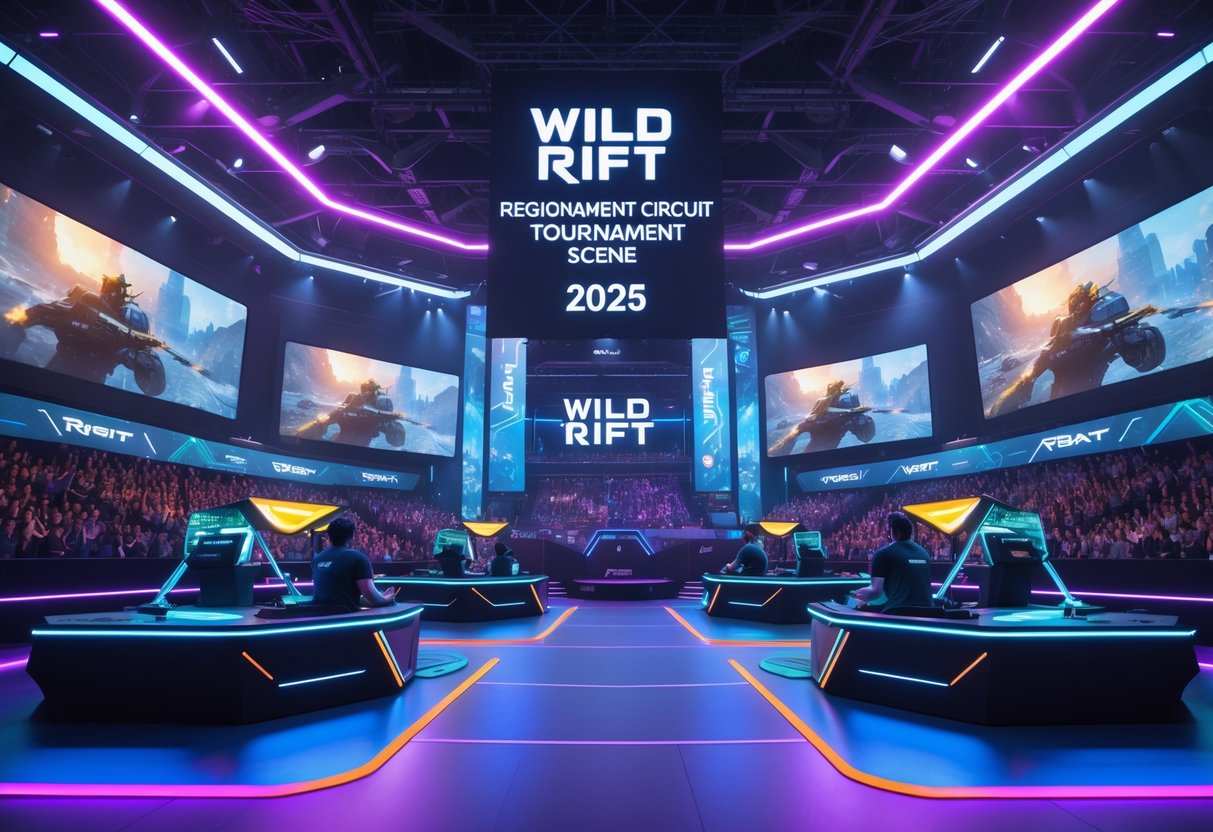
Wild Rift‘s 2025 regional tournament circuit covers three main zones. Each one has its own formats and prize pools.
The Wild Circuit leads in Europe. Asia sticks to established leagues, and up-and-coming regions like Brazil and Turkey host 18 Wild Rounds events throughout the year.
Europe: The Wild Circuit
The Wild Circuit stands as Europe’s top competitive path for Wild Rift teams. The Purge Tournament works with Riot Games to bring this tournament series to life throughout the year.
The circuit includes several tournament levels. Rift Legends Open events run as B-tier tournaments, each with a €2,000 prize pool. Usually, 16 teams jump in for weekend battles. Organizers use the latest game patches, so these events matter for qualifying.
Rift Legends Showdown (RLS) sits at the top. This €4,000 tournament happens from 31 May to 1 June 2025 and only features the best EMEA teams. The format uses Fearless Draft with four teams in a single-elimination bracket. Every match is a best-of-five.
Turkey leads in player representation (35%), with Russia close behind at 23%. France and Germany contribute 19% and 15%. Blam and iTzSTU4RT, both well-known casters, handle the commentary.
Asia: WRL and Regional Leagues
Asia sticks to its established Wild Rift League (WRL) system across the main regions. These leagues follow seasonal formats, much like traditional League of Legends.
The WRL gives teams the most stable competitive environment in the world. Teams play regular season matches, then move into playoff brackets. This setup builds ongoing storylines instead of just one-off tournaments.
Regional leagues in Asia lead directly to international events. The top teams from each country qualify through their own systems. This setup keeps talent developing and ensures every region gets a shot on the global stage.
Brazil, Korea, Turkey, Vietnam, and the Philippines
Wild Rounds marks Riot’s bigger regional push for 2025. Now, 18 tournaments cover five major markets, opening more doors for up-and-coming players.
Brazil takes the lead with several events aimed at growing local talent. Korea keeps its high-level reputation, while Turkey gains from both Wild Rounds and Wild Circuit action.
Vietnam and the Philippines get their own tournament support for the first time. These regions finally have stepping stones for new talent to move up.
Warning: Tournament schedules can change a lot by region. Always check local announcements for dates and how to qualify.
Wild Rounds puts accessibility first, not just elite competition. Prize pools are smaller than in Europe, but anyone can join, making it easier for more people to get involved in these rising esports scenes.
The Purge Tournament and European Scene
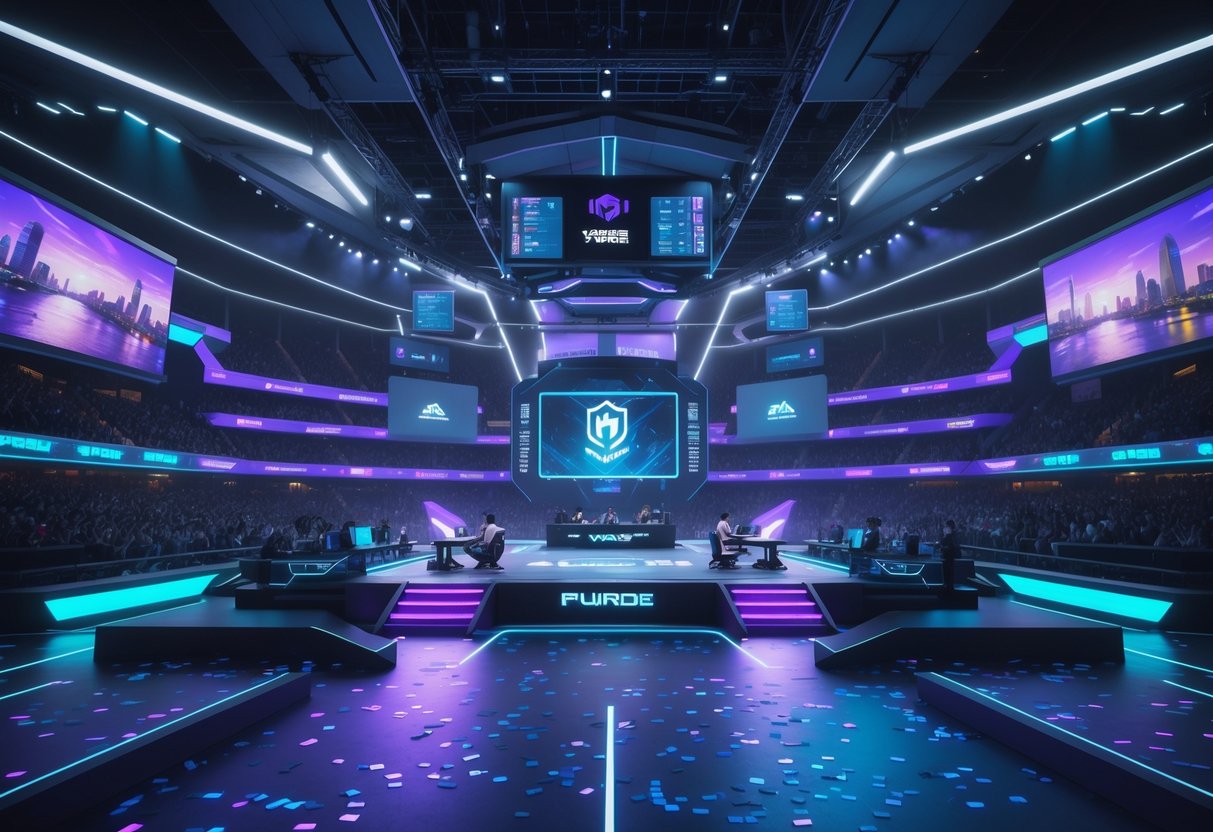
The Purge Tournament has become a big name in European Wild Rift esports, running multiple tournaments in 2025 with Riot Games’ official backing. Their events offer prize pools from €2,000 to €4,000 and pull in the continent’s best players through a mix of formats.
Tournament Formats
The Purge Tournament sets up several unique competition formats inside The Wild Circuit. Their main event, the Rift Legends Showdown, uses a four-team single-elimination bracket. Every match is a best-of-five, with Fearless Draft rules in play.
The Open tournaments take a different path. Open 2, for example, had 16 teams fighting over three days in March 2025. These events stick to specific game patches—Open 2 ran on Patch 6.0d.
Key format features:
- Most events use single-elimination brackets
- Early rounds are best-of-three
- Finals in major tournaments go best-of-five
- Top-tier events use Fearless Draft
Organizers also run The Purge Wild Rift EU Series. This one features four teams in a single-elimination bracket. Most matches are best-of-three, except the Grand Final, which stretches to best-of-five.
Noteworthy Matches
The Rift Legends Showdown brought some unforgettable matchups between Europe’s top teams. The Grand Finals between UB and RM showed off the highest level of Wild Rift in Europe, with both squads pulling out all the stops.
Looking at country stats, Turkish players made up 35% of the field (9 out of 26), with Russians at 23%. French teams sent 19%, and German players filled 15%.
Regional breakdown:
- Turkey: 9 players, including Fakerapo, Fitz, and Nakamura
- Russia: 6 players, with SAHARA and Susanoo among them
- France: 5 players, including Random and Finalwax
- Germany: 4 players, with names like QUANT
Blam and iTzSTU4RT called the action, giving viewers expert analysis across several streaming platforms.
Impact on European Esports
The Purge Tournament’s events have really boosted Wild Rift’s profile in Europe. Prize pools in the thousands of euros push semi-pro and amateur teams to take things seriously.
These tournaments help players climb to higher levels. The structure lets teams build discipline and gain the experience they need to go pro.
Benefits for the scene:
- Regular events for European teams
- Broadcasts that feel professional
- Integration with Riot Games’ official circuit
- Clear steps from amateur to semi-pro play
By working with Riot Games, the organizers give their tournaments a stamp of approval. That kind of backing makes Wild Rift esports in Europe feel legit and draws in more players and organizations.
Their open tournaments let new faces play alongside veterans. This setup keeps grassroots development alive while still keeping things competitive at the top.
Major 2025 Events and Highlights
Wild Rift esports keeps growing, with 18 regional tournaments across five major regions and new international competitions featuring top pro clubs. The tournament lineup now includes women’s teams and bigger prize pools—just in the Philippines, the total hit 1.5 million PHP.
International Competitions
The Wild Circuit 2025 anchors international Wild Rift play. The Rift Legends Showdown brings together EMEA’s best teams for 5v5 action.
This tournament runs from 31st May to 1st June 2025. Teams fight for rankings across Europe, the Middle East, and Africa.
Organizers schedule multiple splits through the year. In the Spring, 16 teams played for €2,000 EUR prize pools in March.
Organised play has expanded to support more competitors worldwide. Riot Games increased support so regional talent can rise to the global stage.
Pro clubs now see a clearer path to major events. The system lets teams move from local tournaments up to international arenas.
Calendar of Top Events
Wild Rounds tournaments now run in Brazil, Korea, Turkey, Vietnam, and the Philippines. Each region has multiple events in 2025.
Key dates:
- March: Spring Split Opens in EMEA
- May-June: Rift Legends Showdown
- Ongoing: Wild Rounds Philippines, with 1.5M PHP up for grabs
The Philippines hosts the year’s biggest community tournament. Split 1 opened with qualifiers, and you can catch match highlights online.
Korea and Vietnam keep their tournament scenes strong. Turkey and Brazil round out the five-region expansion for organized play.
8 top pro clubs compete in permanent circuits. 5 women’s teams have their own competitive tracks alongside the main events.
Prize Pools and Rewards
The Wild Rounds Philippines Open 2025 boasts the biggest prize pool at 1.5 million PHP. That’s the largest community-focused tournament in the region.
In Europe, individual tournaments offer €2,000 EUR pools. The Rift Legends Spring Split Open 2 paid out about $2,177 USD.
Exclusive in-game content celebrates Worlds 2025. Wild Rift offers special rewards for legends like Faker, Showmaker, Uzi, and Deft.
Prize pools change by region and tournament size. B-Tier events usually offer €2,000 EUR, while bigger regional tournaments reach seven digits in local currency.
Wild Rift’s rewards aren’t just cash. Players also get exclusive skins and recognition in the broader League of Legends scene.
Player Pathways and Opportunities
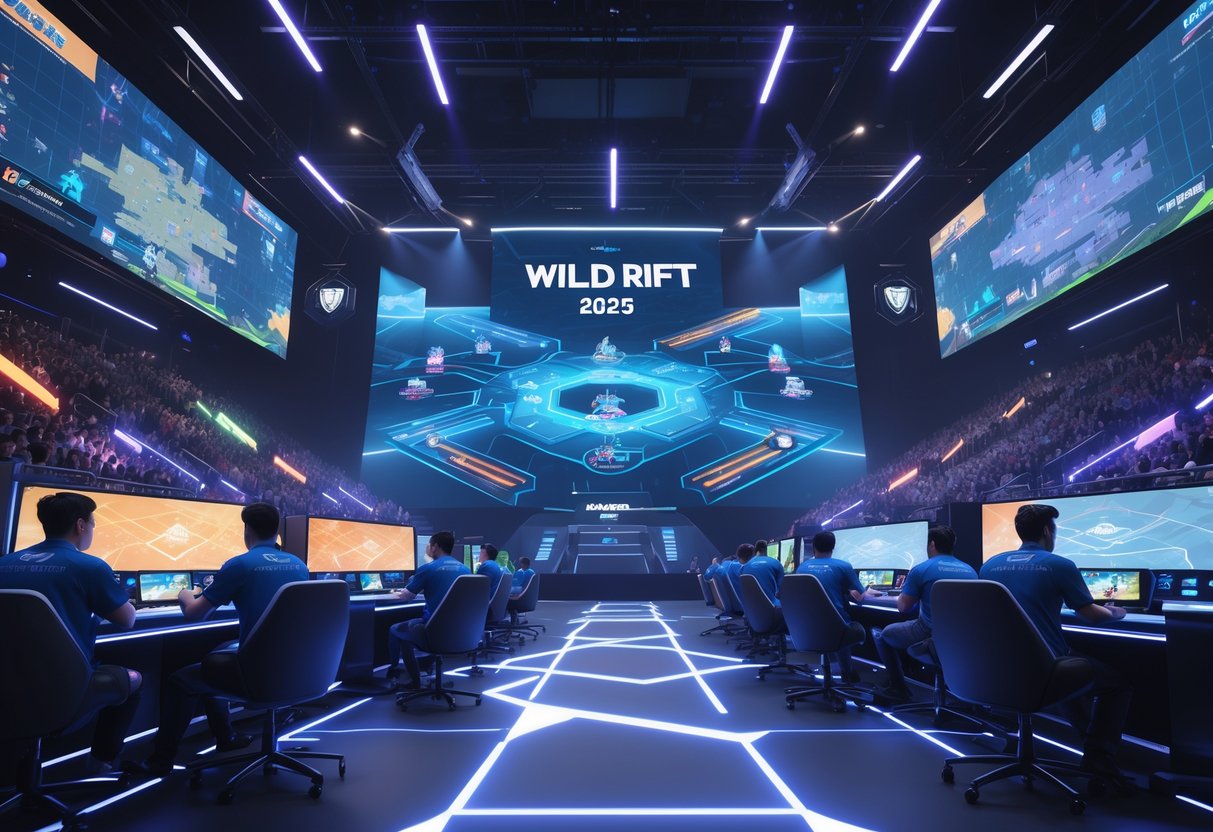
Wild Rift’s 2025 setup lays out clear routes from casual play to pro competition through regional tournaments and community events. The expanded system welcomes traditional players and content creators, offering paths for all skill levels and interests.
Grassroots to Pro Progression
Wild Rift’s regional tournaments give players a real shot at building competitive careers. The 18 Regional Wild Rounds tournaments in Brazil, Korea, the Philippines, Turkey, and Vietnam bring quarterly chances to step up.
Each region hosts three tournaments in 2025. These run in May/June, August/September, and November/December. Players get several shots to compete and improve.
Third-party organisers now work with Riot to run local events. These partnerships open more doors for grassroots players. Local winners can move up into the regional system, which actually forms a competitive ladder.
The path leads to Wild Rounds: SMASH, the year’s final tournament. Top regional performers earn spots to face established pro teams from China. This setup gives rising players a real chance to take on the best.
Influencer Participation
Wild Rift esports mixes competition with content creation. The Influencer track 5v5 format from past Wild Rounds events returns in 2025, making space for streamers and creators.
Mixed formats put influencers together with pro players. The Team Relay includes 1v1 and 2v2 matches, blending both groups. This format keeps things fun for viewers and still holds up competitively.
Community members in all five regions can join Wild Rounds: SMASH. This lets creators actually compete in big events—not just show matches.
Organizers get that fans follow personalities as much as pure skill. By bringing influencers into the mix, Wild Rift lets creators build esports careers too.
Community Engagement
Organised Play stretches competition beyond just big tournaments. These programs target players looking for structure without going full pro.
Riot’s local partners make sure tournaments match each region’s gaming culture. Each territory can design events that fit their own community but still connect to the bigger Wild Rift scene.
The expanded program wants to celebrate and innovate ways for everyone who watches and plays Wild Rift. That means spectators, casual players, and semi-competitive teams all get a place.
18 total events across regions keep the action going all year. Players don’t have to wait for a single championship—quarterly events keep everyone involved.
Innovations in Tournament Formats

Wild Rift tournaments are shaking things up with new competitive structures that mix classic esports with fresh ideas. These changes focus on bringing together different skill levels and making viewer experiences more interesting.
5v5, 1v1, and Relay Structures
Wild Rounds tournaments now use several formats in one event. The usual 5v5 matches still anchor the competition.
But organizers added 1v1 duels and 2v2 relay matches for some variety. These shorter battles keep viewers’ attention when the big team matches take a break.
Tournament Structure Breakdown:
- 5v5 Pro Track: Standard team play
- 1v1 Duels: Fast individual showdowns
- Team Relay: Mixed 1v1 and 2v2 games
The relay format has caught on. Teams rotate through individual and duo matches, testing both solo skill and teamwork.
Wild Rounds: SMASH led the way with this multi-format style. The event proved that mixing things up can make tournaments more dynamic. Other regions are starting to try these varied formats too.
Influencer vs. Pro Matches
Wild Rift tournaments love to mix professional players with content creators and influencers. That blend creates matchups you just don’t see in most traditional esports.
The format splits participants into separate tracks. Pro teams face off in their own division, while influencers battle it out in parallel competitions.
Key Match Types:
- Influencer Track 5v5: Content creators form their own squads
- Mixed Relay: Pros and influencers team up together
- Cross-Division Finals: Winners from each track clash
In Wild Rounds: SMASH, teams like SNG from the Philippines grabbed the influencer track win. At the same time, pro team JT dominated both the pro track and the mixed relay events.
This setup draws in viewers who might not usually care about hardcore esports. Influencer fans want to cheer on their favorite creators, while pro fans get to see the skill gap up close.
Experimental Approaches
Wild Rift is really leaning into community-driven tournament hosting right now. Riot Games is busy building systems so local organizers can run their own affiliated tournaments.
Regional tournaments now show off unique formats designed for each local community. Each of the five regions—Brazil, Korea, Philippines, Turkey, and Vietnam—gets to craft its own competition structure.
The schedule is quarterly, with tournaments in May/June, August/September, and November/December. Organizers get time to experiment and tweak formats between events.
Experimental Elements:
- Community-hosted, Riot-affiliated tournaments
- Prize pools and formats tailored to each region
- Partnerships with local organizers
Wild Rift plans to expand to 18 regional tournaments in 2025, giving them plenty of room to test new ideas. When a format works at a regional level, they roll it out to bigger events like Wild Rounds: SMASH.
Staying experimental helps Wild Rift tournaments keep things fresh and actually listen to what the community wants.
In-Game Content and Community Integration
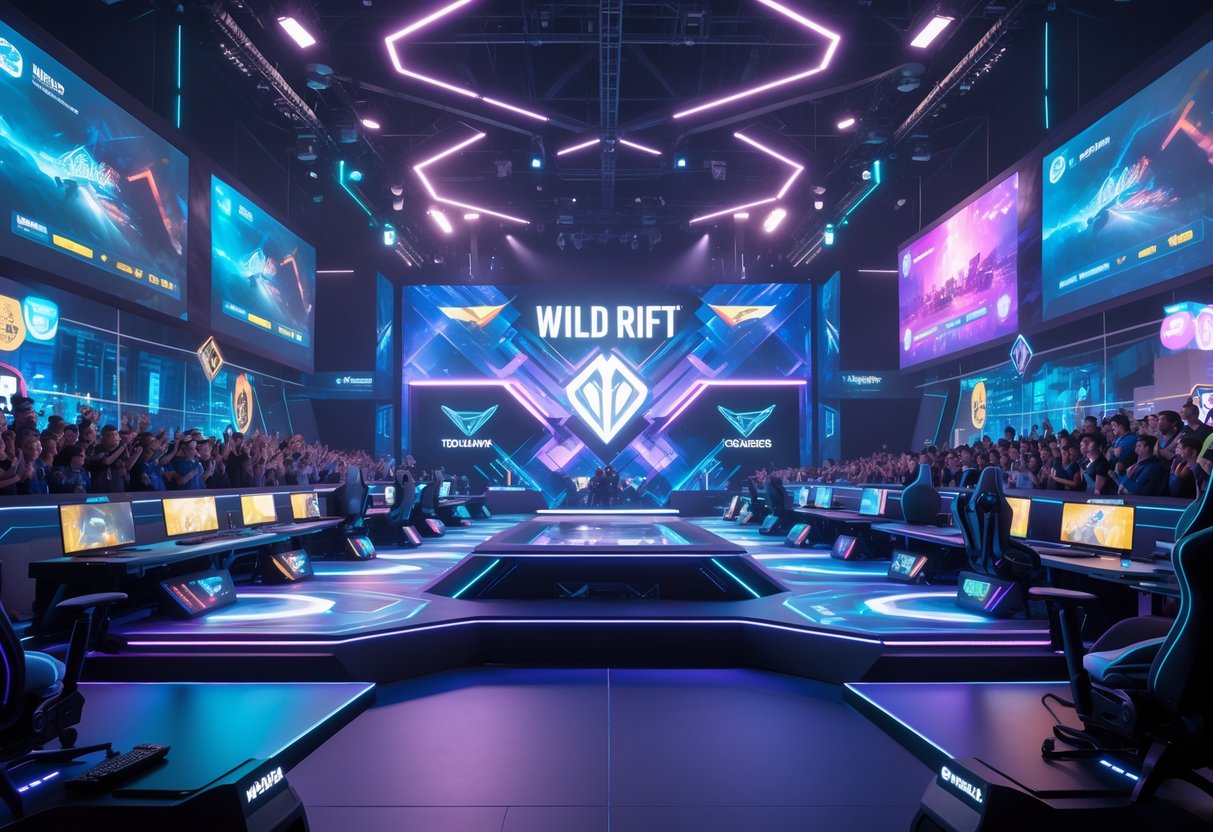
Wild Rift is rolling out special rewards and missions tied to big esports events in 2025. Riot Games says they want to celebrate League of Legends’ competitive history with exclusive content that helps mobile players connect with the wider esports scene.
Worlds 2025 Inspired Rewards
Wild Rift is dropping exclusive Worlds 2025 content during this year’s championship. Riot Games says these rewards will celebrate League of Legends esports history.
The mobile game will feature special themed rewards that honor the competitive scene‘s biggest moments. Players can expect unique cosmetics and items that you can’t get anywhere else.
Riot plans to share more details on these rewards this autumn. The goal? Boost player engagement during the tournament period.
Wild Rift keeps trying to connect mobile players with League’s competitive legacy. Past events even included collaborations with pros like Faker.
Special Missions and Skins
The Worlds 2025 event brings time-limited missions for Wild Rift players. These challenges will probably reward you for watching matches or hitting certain in-game goals.
Expect some special championship-themed skins too. These cosmetics let you show off support for your favorite teams and regions.
Riot usually creates mission chains that unlock different rewards as you progress. That format encourages players to log in every day during the tournament.
Missions will likely ask you to watch official tournament streams. It’s a clever way to boost viewership while rewarding the most engaged players.
Celebrating Esports Legacy
Wild Rift’s Worlds content will highlight League of Legends’ competitive history. That means memorable moments, legendary players, and iconic team victories.
This celebration lines up with Wild Rift’s shift in esports focus. Since 2020, the game has moved from global competition to more regional scenes, especially in Asia.
China’s Wild Rift Super League now leads the way for pro play on mobile. The Worlds content will likely nod to these regional powerhouses.
This approach helps new mobile players get a feel for League’s deep competitive background. It also bridges the gap between Wild Rift and the main League of Legends esports scene.
The Future of Wild Rift Esports
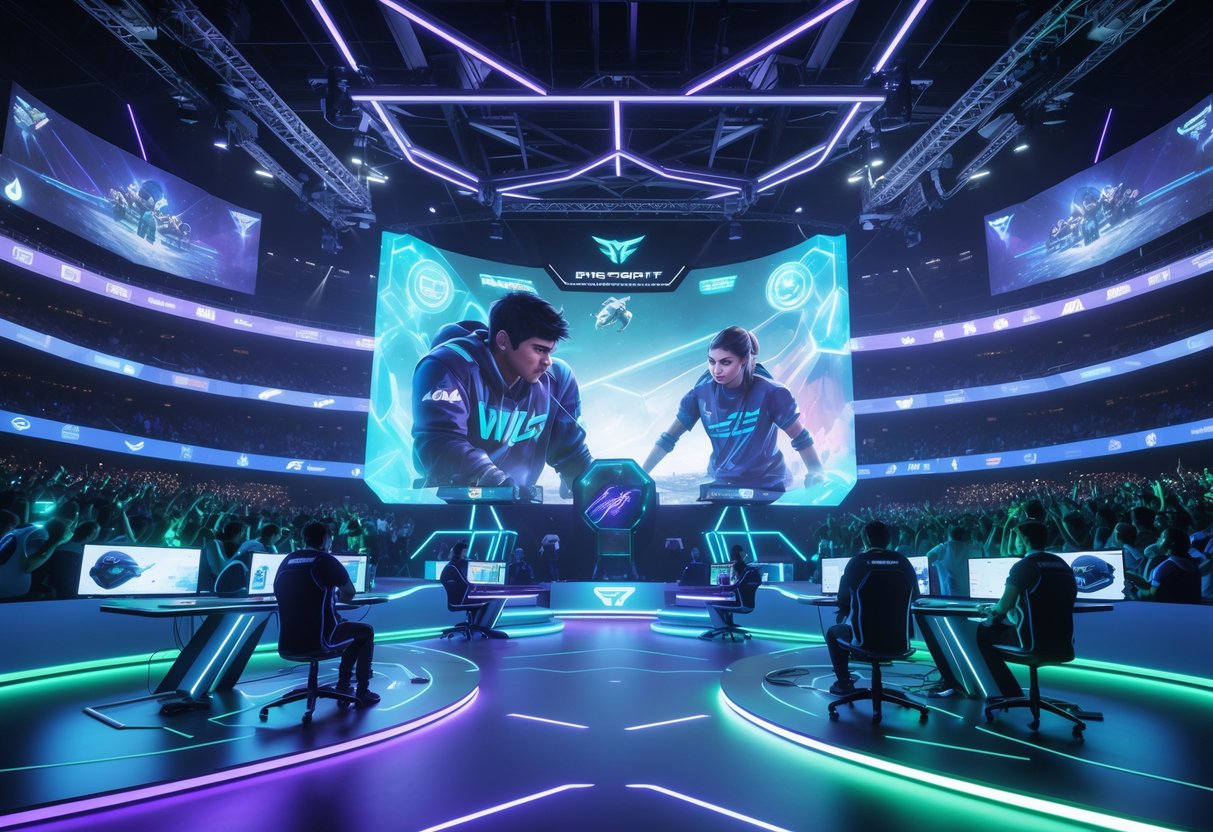
Riot Games is shaking up Wild Rift esports in 2025 with a new focus on community-driven competition instead of just sticking to old-school tournament formats. The plan is to run 18 regional events through Wild Rounds and tie mobile gameplay even closer to League of Legends’ main esports ecosystem.
Upcoming Changes and Announcements
Riot Games has moved Wild Rift esports away from traditional formats and toward Wild Rounds and Organised Play programs. That’s a pretty big shift from the tournament scene we saw in the past.
The new approach mixes pro-level matches with influencer participation. Riot wants to prioritize entertainment and community engagement, not just competitive integrity.
Key changes include:
- 18 regional Wild Rounds events across Brazil, Korea, and the Philippines
- Partnering with The Purge Tournament for Europe’s Wild Circuit series
- Tighter integration with League of Legends World Championship content
Wild Rift will drop exclusive in-game content during Worlds 2025. This ties the mobile game directly to League’s main esports calendar, which honestly, they didn’t really do before.
The timing makes sense. North American tournaments have been quiet for months, and Europe’s last official event was all the way back in 2023.
Long-Term League Development
The esports scene faces some real regional challenges Riot needs to tackle. Western markets aren’t seeing much tournament action, and North America is basically dormant.
Europe leans on third-party organizers like The Purge Tournament. The Wild Circuit 2025 features events like the Rift Legends Spring Split Showdown, running from 31 May to 1 June 2025.
Riot says they’re focusing on sustainable growth over rapid expansion. They admit they’re learning from their “inaugural year” and making adjustments.
It looks like Riot is okay with Wild Rift not matching League’s traditional esports success. Instead, they’re building something new that fits mobile gaming culture better.
Regional focus areas:
- Asia-Pacific: Strong grassroots support
- Brazil: Frequent regional tournaments
- Europe: Partner-driven events
- North America: Almost no activity
Expanding Organised Play Globally
Organised Play is Riot’s biggest bet for Wild Rift’s future. Instead of chasing expensive pro leagues, they’re investing in more accessible, community-driven competitions.
Wild Rounds focuses on fun rather than strict competition. That means mixing pros with content creators and community figures.
Riot partners with regional tournament organizers instead of running everything themselves. In Europe, The Purge Tournament handles the Wild Circuit series. That keeps costs down and still delivers quality events.
Global expansion strategy:
- Regional partnerships to keep things efficient
- Community-focused events instead of pro leagues
- Tighter integration with League of Legends content
- More emphasis on entertainment
This approach recognizes that mobile esports fans want something different. Mobile players usually prefer shorter, more casual competitions compared to PC gamers.
Riot is betting that community-driven competition will last longer than trying to force classic esports models onto mobile.
Frequently Asked Questions
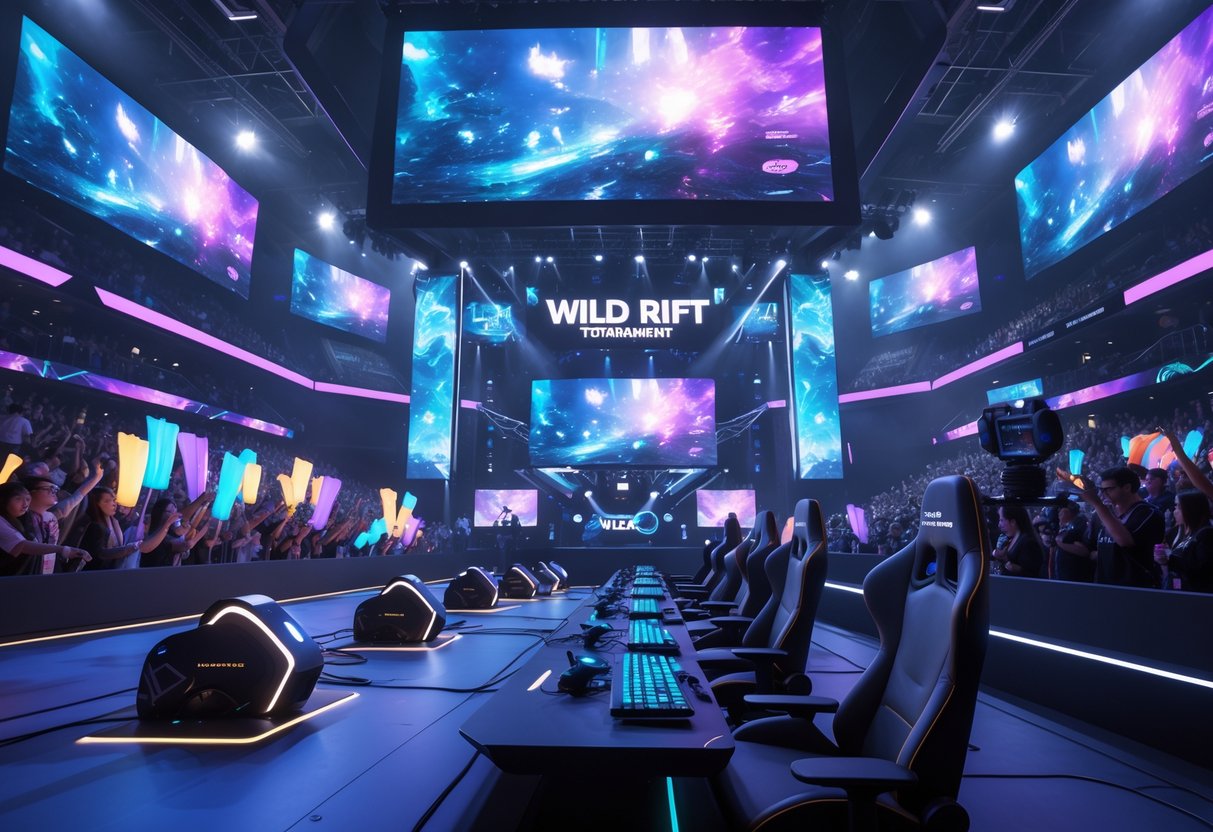
Wild Rift tournaments in 2025 bring more regional competitions, new esports content celebrating League of Legends history, and prize pools that range from €4,000 for regional events to major international championships.
What are the must-watch Wild Rift tournaments scheduled for this year?
The Rift Legends Showdown stands out as a top European tournament happening from 31 May to 1 June 2025. This event has a €4,000 prize pool and features the best EMEA teams in single-elimination Bo5 brackets.
Wild Rounds has grown a lot this year, with 18 regional events. These tournaments span Brazil, Korea, Turkey, Vietnam, and the Philippines, giving local players a shot at competitive success.
The CarnaWild tournament in Brazil wrapped up recently as the first major Wild Rounds event. Europe is getting more tournament support in 2025, with several regional competitions lined up.
Quick win: Follow the Rift Legends circuit for steady, high-level competition and a clear path from Open tournaments to the main Showdown.
Could you share some tips on how to qualify for the top Wild Rift competitions?
Most big tournaments use a tiered qualification system that starts with Open events. The Rift Legends circuit runs from February to June, beginning with Open 1 and moving through several stages to the final Showdown.
Regional Wild Rounds tournaments give players a chance to climb the competitive ladder and maybe even rank among their country’s best.
Practice with the Fearless Draft format, since many top tournaments use it now. Teams can’t pick the same champion twice in a series, so you’ll need a deep champion pool and some strategic flexibility.
Warning: Tournament formats can be really different depending on your region, so check the qualification rules for your area before you dive in.
Who are currently the most successful teams in the Wild Rift esports scene?
The Rift Legends Showdown has a strong showing from Turkey, with 35% of players coming from there. Turkish players like B1essed, Carlos, and Fakerapo are making a name for themselves.
Russian teams account for 23% of top EMEA tournament players. Names like Hanwa, Kaktus, and QueeNie pop up at the highest levels.
French and German teams also have a big impact on the European meta. You’ll see French players such as Ezem and Finalwax, and German competitors like craiz and QUANT, shaping the competition.
Country representation in top tournaments often matches up with how much each region invests in player development.
Where can fans watch the live broadcasts of Wild Rift Championship games?
The Rift Legends Showdown features commentators Blam and iTzSTU4RT (Stuart Gilson) doing live coverage. Most major tournaments offer several streaming options, including co-streams.
Broadcasts usually have analysis between matches and post-game interviews. Commentary teams break down strategies so both new and experienced viewers can follow along.
Regional tournaments often stream in local languages as well as English. That way, fans can cheer for their home teams with familiar commentary.
Quick win: Follow tournament organizers like The Purge Tournament on social media for broadcast times and stream links.
What have been the biggest surprises or upsets in recent Wild Rift tournaments?
The jump from a handful of regional Wild Rounds to 18 tournaments worldwide caught a lot of people off guard. That’s a big investment in grassroots competition.
Turkey’s dominance in European tournaments wasn’t something most fans predicted at the start. Now, the region produces over a third of top EMEA players.
Regional prize pools have gotten a boost, even with smaller events like the Rift Rumble offering $500 USD. It’s a sign of more financial support at every level.
Integrating Worlds 2025 content into Wild Rift shows Riot’s commitment to connecting mobile and PC esports scenes.
How has the Wild Rift competitive rule set evolved since the game’s release?
These days, Fearless Draft stands as the go-to format for major tournaments. Teams can’t pick the same champions twice in a series, so you end up seeing way more creative drafts.
Top-tier events now run with Bo5 (Best of 5) matches. That shift from shorter series gives teams more chances to adapt, and honestly, it makes comebacks a lot more exciting.
Some regional tournaments swapped out round-robin formats for single-elimination brackets. That change cranks up the pressure for each match and keeps the whole event moving faster.
Riot Games has really stepped up its tournament support lately. You see official backing and even in-game content tied to events, which makes the whole competitive scene feel more legit.
Next: Pick an upcoming tournament that catches your eye, follow your favorite teams, and see what meta strategies they’re bringing to the table at the highest level.

